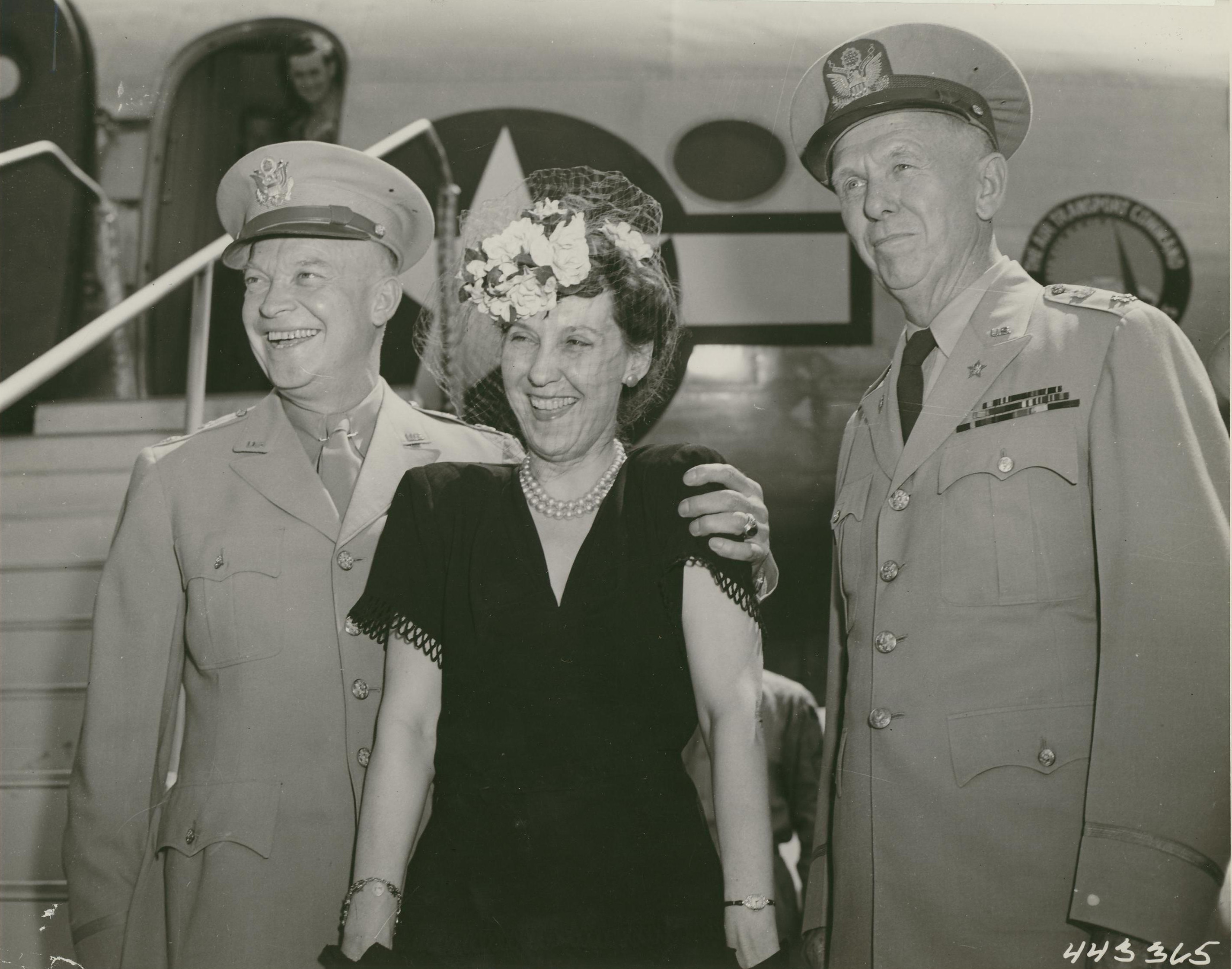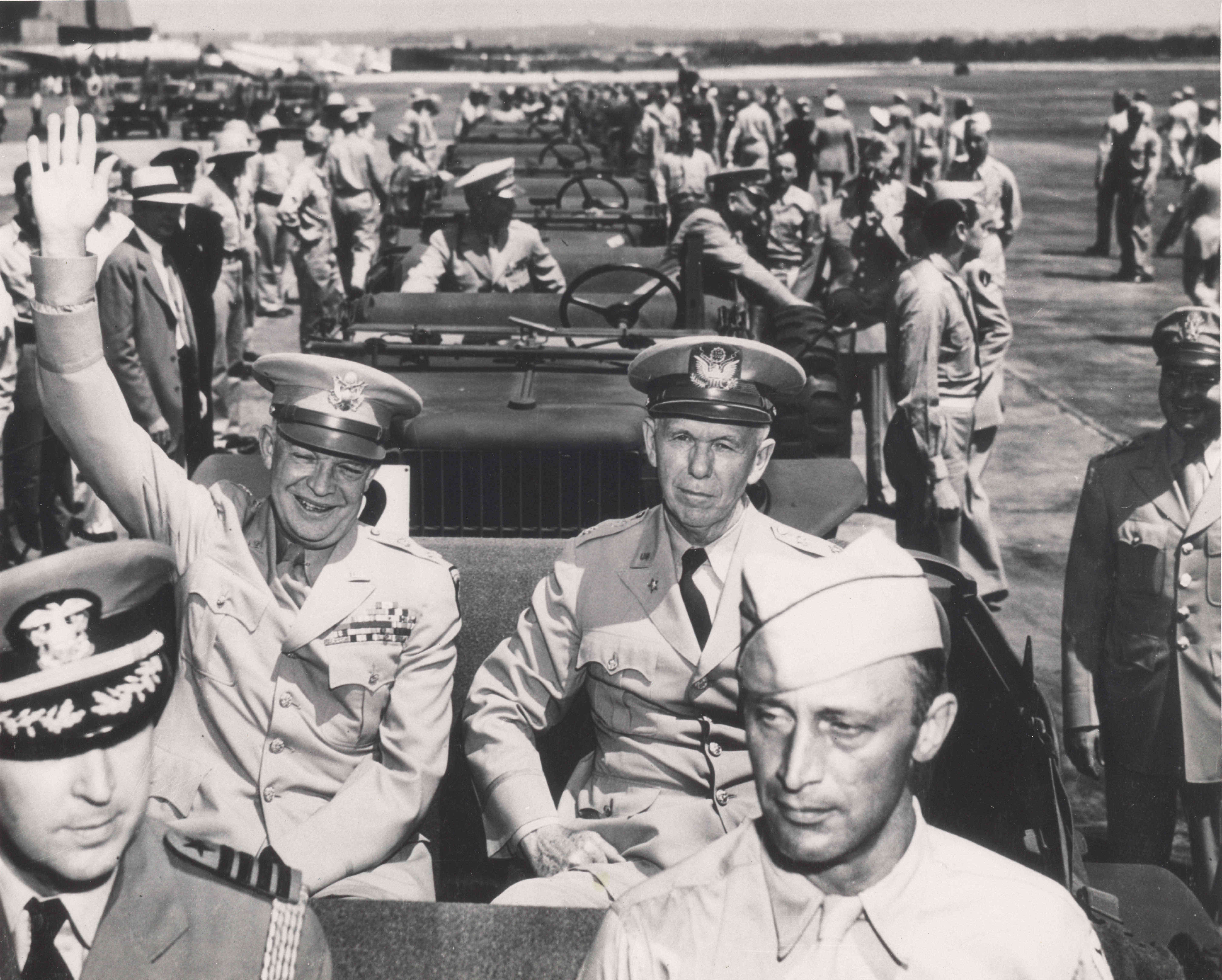On the morning of June 18, 1945, General George C. Marshall, waited with Mrs. Mamie Eisenhower at National Airport in Washington, D.C., for the arrival of General Dwight D. Eisenhower. The purpose of the visit was to give General Eisenhower a proper homecoming, complete with parades and other celebrations, to recognize his remarkable efforts in leading the Allies to victory in Europe. The return to the United States also afforded Eisenhower the opportunity for a much-needed rest after enduring the strain of war for more than three years.
the morning of June 18, 1945, General George C. Marshall, waited with Mrs. Mamie Eisenhower at National Airport in Washington, D.C., for the arrival of General Dwight D. Eisenhower. The purpose of the visit was to give General Eisenhower a proper homecoming, complete with parades and other celebrations, to recognize his remarkable efforts in leading the Allies to victory in Europe. The return to the United States also afforded Eisenhower the opportunity for a much-needed rest after enduring the strain of war for more than three years.
General Marshall, who had taken an active interest in making arrangements for General Eisenhower’s return, sent a number of radio messages outlining the proposed schedule of events, so that Eisenhower would know what to expect when he arrived. Eisenhower’s plane landed at 11:30 A.M. He first greeted his wife with what newspaper reporters described as “a bear hug and a Hollywood kiss,” then his in-laws, and finally General Marshall. Newspaper photographers captured several scenes of General and Mrs. Eisenhower standing with General Marshall to mark the occasion.
As the group departed from the airport for the Pentagon, Marshall rode with Eisenhower. At the Pentagon Secretary of War Henry L. Stimson greeted General Eisenhower and then Eisenhower spoke briefly to thank the many people in the War Department for their support. Marshall remained at the Pentagon while Eisenhower departed for a parade through Washington, D.C. After the parade Eisenhower went to the Capitol for a reception arranged by Congress at which General Marshall, along with the other chiefs of staff, was present.
General Eisenhower’s homecoming to the United States provided Marshall and Eisenhower with a short break from the complex problems they faced. A short time later both generals resumed their heavy workload with Eisenhower confronting the challenges of occupation and demobilization while Marshall turned his attention to defeating the Japanese in the Pacific.
In a radio message to Eisenhower dated September 4, 1945, just two days after World War II ended, Marshall wrote, “While I have no indication from the president as to the date he will accept my release as Chief of Staff, I do not think there is a shadow of a doubt regarding your appointment to succeed me.” Marshall’s message indicated the complete confidence that he had in Eisenhower. Interestingly, at the conclusion of the war in Europe, Eisenhower had expressed a similar sentiment to Marshall writing, “the strongest weapon that I have always had in my hand was a confident feeling that you trusted my judgment.” The admiration and respect that Marshall and Eisenhower had for one another as well as their strong camaraderie was easily recognizable.
 In the years that followed, the friendship that Marshall and Eisenhower had forged during World War II began to change. Marshall, who wanted nothing more than to retire and turn his attention to tending his garden and other outdoor pursuits, dutifully accepted President Harry S. Truman’s appointments as Special Ambassador to China, Secretary of State, President of the American Red Cross, and Secretary of Defense. Eisenhower succeeded Marshall as Chief of Staff of the Army and then served as the president of Columbia University. Eisenhower avoided politics while serving on active duty, but after his retirement he eventually gave in to the pressure to seek the presidency. He won the Republican nomination and the general election in 1952, and on January 20, 1953, he was sworn in as President of the United States.
In the years that followed, the friendship that Marshall and Eisenhower had forged during World War II began to change. Marshall, who wanted nothing more than to retire and turn his attention to tending his garden and other outdoor pursuits, dutifully accepted President Harry S. Truman’s appointments as Special Ambassador to China, Secretary of State, President of the American Red Cross, and Secretary of Defense. Eisenhower succeeded Marshall as Chief of Staff of the Army and then served as the president of Columbia University. Eisenhower avoided politics while serving on active duty, but after his retirement he eventually gave in to the pressure to seek the presidency. He won the Republican nomination and the general election in 1952, and on January 20, 1953, he was sworn in as President of the United States.
